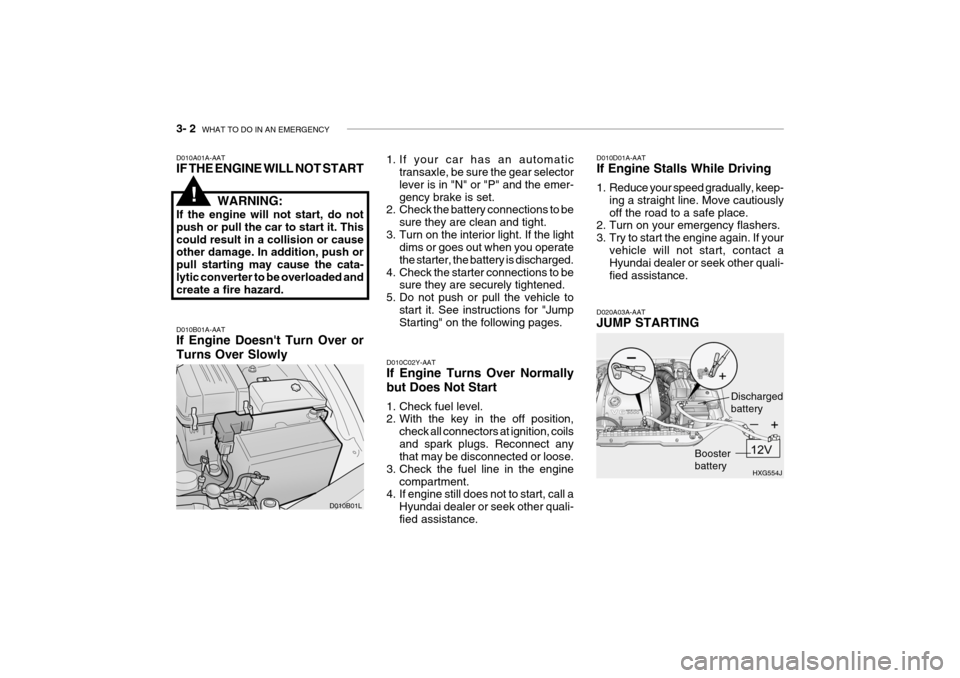2004 Hyundai Grandeur jump start
[x] Cancel search: jump startPage 156 of 235

3. WHAT TO DO IN AN EMERGENCY
If the Engine Will not Start .............................................................. 3-2
Jump Starting .................................................................................. 3-2
If the Engine Overheats .................................................................. 3-4
Spare Tire ....................................................................................... 3-5
If You Have a Flat Tire .................................................................... 3-5
If Your Car Must Be Towed ..........................................................3-10
Emergency Towing ....................................................................... 3-12
If You Lose Your Keys .................................................................. 3-12
3
Page 157 of 235

3- 2 WHAT TO DO IN AN EMERGENCY
D010A01A-AAT IF THE ENGINE WILL NOT START
WARNING:
If the engine will not start, do not push or pull the car to start it. Thiscould result in a collision or cause other damage. In addition, push or pull starting may cause the cata-lytic converter to be overloaded and create a fire hazard. D010B01A-AAT If Engine Doesn't Turn Over or Turns Over Slowly 1. If your car has an automatic
transaxle, be sure the gear selector lever is in "N" or "P" and the emer-gency brake is set.
2. Check the battery connections to be
sure they are clean and tight.
3. Turn on the interior light. If the light dims or goes out when you operatethe starter, the battery is discharged.
4. Check the starter connections to be sure they are securely tightened.
5. Do not push or pull the vehicle to start it. See instructions for "Jump Starting" on the following pages. D010D01A-AAT If Engine Stalls While Driving
1. Reduce your speed gradually, keep-
ing a straight line. Move cautiously off the road to a safe place.
2. Turn on your emergency flashers.
3. Try to start the engine again. If your
vehicle will not start, contact a Hyundai dealer or seek other quali- fied assistance.
D010C02Y-AAT If Engine Turns Over Normally but Does Not Start
1. Check fuel level.
2. With the key in the off position, check all connectors at ignition, coils and spark plugs. Reconnect any that may be disconnected or loose.
3. Check the fuel line in the engine compartment.
4. If engine still does not to start, call a
Hyundai dealer or seek other quali- fied assistance.
D010B01L
D020A03A-AAT JUMP STARTING
HXG554J
Dischargedbattery
Booster battery
!
Page 158 of 235

WHAT TO DO IN AN EMERGENCY 3- 3
WARNING:
The gas produced by the battery during the jump-start operation is highly explosive. If these instruc- tions are not followed exactly, seri-ous personal injury and damage to the vehicle may occur! If you are not sure how to follow this proce-dure, seek qualified assistance. Automobile batteries contain sul- furic acid. This is poisonous andhighly corrosive. When jump start- ing, wear protective glasses and be careful not to get acid on yourself,your clothing or on the car.
o If you should accidentally get acid on your skin or in your eyes, imme- diately remove any contaminatedclothing and flush the area with clear water for at least 15 minutes. Then promptly obtain medical attention. Ifyou must be transported to an emer- gency facility, continue to apply water to the affected area with a spongeor cloth. o The gas produced by the battery
during the jump-start operation ishighly explosive. Do not smoke orallow a spark or open flame in the vicinity.
o The battery being used to provide the jump start must be 12-volt. If youcannot determine that it is a 12-volt battery, do not attempt to use it forthe jump start.
o To jump start a car with a discharged
battery, follow this procedure ex-actly:
1. If the booster battery is installed in another vehicle, be sure the two vehicles are not touching.
2. Turn off all unnecessary lights and
accessories in both vehicles.
3. Attach the clamps of the jumper
cable in the exact order shown in the illustration. That is, first, attach one clamp of the jumper cable to the positive (+) post or cable of thedischarged battery. Then attach the other end of the same cable to the positive (+) post or cable of thebooster battery. Next, using the other cable, attach one clamp to the negative (-) post or cable of the booster battery. Then attach the other end of that cable to a solid metal part of the engine of the ve-hicle with the discharged battery away from the battery. Do not con- nect the cable to any moving part.
4. Start the engine in the car with the booster battery and let it run for afew minutes. This will help to as-sure that the booster battery is fully charged. During the jumping opera- tion, run the engine in this vehicle atabout 2,000 rpm.
5. Start the engine in the car with the
discharged battery using the nor-mal starting procedure. After the engine starts, leave the jumper cables connected and let the enginerun at fast idle or about 2,000 rpm for several minutes.
6. Carefully remove the jumper cables
in the reverse order of attachment.
If you do not know why your battery became discharged (because the lights were left on, etc.), have the charging system checked by your Hyundaidealer.!
Page 233 of 235

10- 4 INDEX
H Hazard Warning Syst em ........................................... 1-54
Headlight Aiming Adjustment ....................................6-25
Headlight Leveling Device Syst em ...........................1-75
Heating and Ventilation ................................. 1-80 ~ 1-93
Air flow control ..................... 1-82 ~ 1-83, 1-91 ~ 1-92
Air intake control .................. 1-81 ~ 1-82, 1-90 ~ 1-91
Bi-level heating ....................................................... 1-84
Fan speed control ........................................ 1-81, 1-90Temperature control ............................................... 1-84
High-Mounted Rear Stop Light................................. 1-69
Hood Release ........................................................... 1-70
Horn .......................................................................... 1-74
IIgnition Sw itch ............................................................. 2-3
Illuminated Ignition Switch .......................................... 1-5
Immobilizer System ........................................... 1-4 ~ 1-5
Instrument Cluster and Indicator Lights ....... 1-41 ~ 1-46
Instrument Panel Light Control (Rheo stat)............... 1-57
Intergrated Memory System (I. M. S) .......... 1-16 ~ 1-17Interior Light Interior light ................................................ 1-62 ~ 1-63
Map light .................................................... 1-61 ~ 1-62
Personal light ......................................................... 1-63
Intermittent Wiper ..................................................... 1-53
J Jump Starting .................................................... 3-2 ~ 3-3 K
Key .................................................................... 1-3 ~ 1-4
If you lose your keys ............................................. 3-12
Positions ......................................................... 2-3 ~ 2-4
L Lubrication Chart ......................................................... 9-4
Luggage Net ............................................................. 1-72
MMaintenance Intervals Explanation of scheduled maintenance items
....................................................................... 5-7 ~ 5-9
Maintenance under severe usage conditions .......... 5-6Scheduled maintenance ................................. 5-4 ~ 5-5
Service requ irements............................................... 5-2
Mirrors Day-night inside rearview ....................................... 1-65
Outside rearview mirror heater .............................. 1-64
O
Odometer ...................................................... 1-48 ~ 1-49
Outside rearview mirror ............................................ 1-64
PParking Brake ........................................................... 1-66
Passenger Presence Detec tion .............................. 1-36
Power Outle t ............................................................. 1-71
Power Seat ............................................................... 1-14